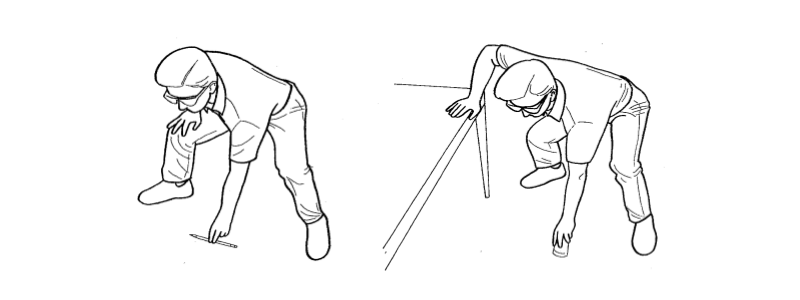To understand how to lift small objects off of the floor, you must first understand the Spinal Leverage Ratio. This is a formula that will tell you how much you are loading your back when you are lifting. It is a 10 to 1 ratio, where you multiply the weight of the load by 10, and that tells you how much you are loading your back when you lift. As an example, if you are lifting a 50 lb. load off the floor with your back, you will load your spine with some 1,000 lbs. of pressure to do the lift. The spine can take 1,000 lbs. of pressure, however, it cannot take it for very long and eventually is wears out. Using the 10 to 1 Spinal Leverage Ration formula however, one would think that lifting a 50 lb. load with your back would only load your spine with 500 lbs. of pressure. However, we often fail to take into account the weight of our upper body that is levered out over the load as we lift. Even a small person will have at least 50 lbs. of upper body weight that is then levered out over the load. So, in the 50 lb. box example, we have the 50 lb. weight of the box, plus the 50 lb. weight of the upper body, added together equal 100 lbs. 100 lbs. x 10 = 1,000 lbs. When lifting something like a pencil off of the floor, remember that it is not the weight of the pencil that makes any difference in the lift, but rather the weight of your upper body.
To use your legs to lift small items off of the floor, simply step out in wide stance over the item, bend your knees to 100 degrees, then go forward at the hip sockets, pick up the item, come back up at the hip sockets, then up at the knees, and continue on your way. To do this lift, however, don’t make it a mechanical, one move at a time, type lift. Rather make it all one very smooth operation. As you are going down with your knees, you are going forward at the hips at the same time, and this makes it a very easy, smooth transition. Remember also, if it is a one-handed lift, use your free hand to bridge to your leg or to a piece of equipment, to help lower you down to the floor as you lift. Learning to lift this way even for small objects, will help keep anywhere from 500—1,000 lbs. of pressure off of your back on a repetitive basis.


Recent Comments